
John Chrysostom was an important Early Church Father who served as archbishop of Constantinople. He is known for his preaching and public speaking, his denunciation of abuse of authority by both ecclesiastical and political leaders, his Divine Liturgy of Saint John Chrysostom, and his ascetic sensibilities. The epithet Χρυσόστομος means "golden-mouthed" in Greek and denotes his celebrated eloquence. Chrysostom was among the most prolific authors in the early Christian Church, although both Origen of Alexandria and Augustine of Hippo exceeded Chrysostom.
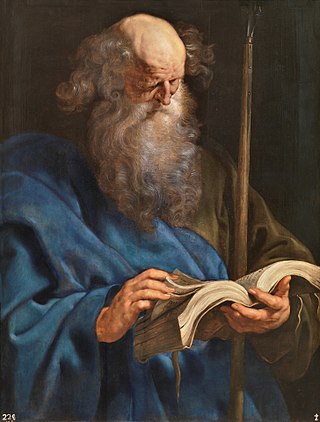
Thomas the Apostle, also known as Didymus, was one of the Twelve Apostles of Jesus according to the New Testament. Thomas is commonly known as "Doubting Thomas" because he initially doubted the resurrection of Jesus Christ when he was told of it ; he later confessed his faith on seeing the wounds left over from the crucifixion.

Eastern Christianity comprises Christian traditions and church families that originally developed during classical and late antiquity in Eastern Europe, Southeastern Europe, Asia Minor, the Caucasus, Northeast Africa, the Fertile Crescent and the Malabar coast of South Asia, and ephemerally parts of Persia, Central Asia, the Near East and the Far East. The term does not describe a single communion or religious denomination.

Clotilde, also known as Clothilde, Clotilda, Clotild, Rotilde etc., was a Queen of All the Franks. She was supposedly descended from the Gothic king Athanaric and became the second wife of the Frankish king Clovis I in 493. The Merovingian dynasty to which her husband belonged ruled Frankish kingdoms for over 200 years (450–758).
Vincent of Lérins was a Gallic monk and author of early Christian writings. One example was the Commonitorium, c. 434, which offers guidance in the orthodox teaching of Christianity. Suspected of semipelagianism, he opposed the Augustinian model of grace and was probably the recipient of Prosper of Aquitaine's Responsiones ad Capitula Objectionum Vincentianarum. His feast day is celebrated on 24 May.

The history of Christianity in Ukraine dates back to the earliest centuries of the history of Christianity, to the Apostolic Age, with mission trips along the Black Sea and a legend of Saint Andrew even ascending the hills of Kyiv. The first Christian community on territory of modern Ukraine is documented as early as the 9th century with establishment of the Metropolitanate of Gothia centered in Crimean peninsula. However, on territory of the Old Rus in Kyiv it became the dominant religion since its official acceptance in 989 by Vladimir the Great, who brought it from Byzantine Crimea and installed it as the state religion of medieval Kyivan Rus (Ruthenia), with the metropolitan see in Kyiv.
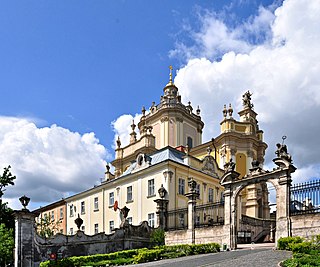
The Ukrainian Greek Catholic Church is an Eastern Catholic particular church that is in full communion with the Holy See and the rest of the Catholic Church. It is the second-largest particular church in the Catholic Church, second only to the Latin Church. As a major archiepiscopal church, it is governed by a Major Archbishop; the incumbent is Sviatoslav Shevchuk.

Josaphat Kuntsevych, OSBM was a Basilian monk and archeparch of the Ruthenian Catholic Church who on 12 November 1623 was killed by an angry mob in Vitebsk, in the eastern peripheries of the Polish–Lithuanian Commonwealth. He is said to be the best-known victim of anti-Catholic violence related to implementing the Union of Brest, and has been declared a martyr and saint of the Catholic Church.

Saint Pantaleon, counted in Western Christianity as among the late-medieval Fourteen Holy Helpers and in Eastern Christianity as one of the Holy Unmercenary Healers, was a martyr of Nicomedia in Bithynia during the Diocletianic Persecution of 305 AD.

Zhovkva is a city in Lviv Raion, Lviv Oblast (region) of western Ukraine. Zhovkva hosts the administration of Zhovkva urban hromada, one of the hromadas of Ukraine. Its population is approximately 13,852 .

Holy Dormition Pochaiv Lavra, also sometimes known as the Pochaiv Monastery, is a monastery and lavra in Pochaiv, Kremenets Raion, Ternopil Oblast, Ukraine. The monastery belongs to the Ukrainian Orthodox Church. For centuries, it has been the foremost spiritual and ideological centre of various Orthodox and Eastern Catholic denominations in Western Ukraine. The monastery tops a 60-metre hill in the town of Pochayiv, 18 km southwest of Kremenets and 70 km north of Ternopil.
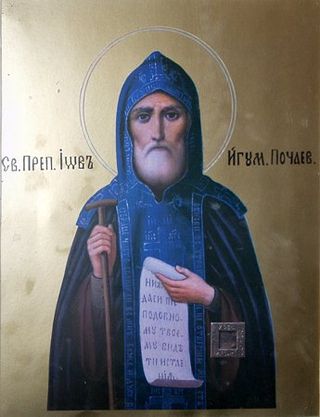
Job of Pochayev, to the world Ivan Ivanovich Zheleza, in Great Schema John was an Eastern Orthodox monk and saint.

Christianity has been, historically, a Middle Eastern religion with its origin in Judaism. Eastern Christianity refers collectively to the Christian traditions and churches which developed in the Middle East, Egypt, Asia Minor, the Far East, Balkans, Eastern Europe, Northeastern Africa and southern India over several centuries of religious antiquity. It is contrasted with Western Christianity, which developed in Western Europe. As a historical definition the term relates to the earliest Christian communities and their long-standing traditions that still exist.

The Archeparchy of Lviv is an ecclesiastical territory or ecclesiastical province of the Ukrainian Greek Catholic Church — a particular Eastern Catholic Church, that is located in Ukraine. It was erected in 1807. As a metropolitan see, it has three suffragan sees: Stryi, Sambir-Drohobych, and Sokal–Zhovkva. The incumbent Metropolitan Archbishop is Ihor Vozniak. The cathedral church of the archeparchy is St. George's in the city of Lviv.
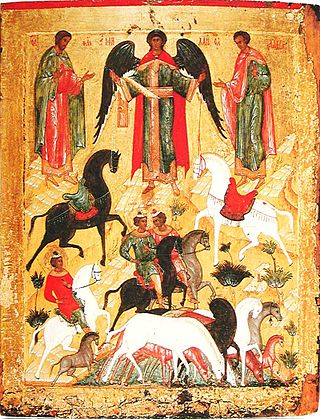
Saints Florus and Laurus are venerated as Christian martyrs of the 2nd century. According to a Greek tale, they were twin brothers who worked as stonemasons. They were originally from Constantinople, Byzantium but settled in Ulpiana, Dardania, south of Pristina, Kosovo in the district of Illyricum. They were educated in the art of masonry by two men named Maximus and Proculus, who were Christians.
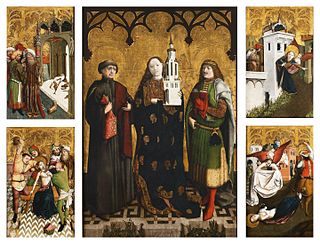
Saint Barbara, known in the Eastern Orthodox Church as the Great Martyr Barbara, was an early Christian Lebanese and Greek saint and martyr. Accounts place her in the 3rd century in Heliopolis Phoenicia, present-day Baalbek, Lebanon, and recent discovered texts in the Saida early church archives suggest her maternal grandmother is a descendant from Miye ou Miye village. There is no reference to her in the authentic early Christian writings nor in the original recension of Saint Jerome's martyrology.

Andrew the Apostle, also called Saint Andrew, was an apostle of Jesus according to the New Testament. He is the brother of Simon Peter and is a son of Jonah. He is referred to in the Orthodox tradition as the First-Called.

Stephen is traditionally venerated as the protomartyr or first martyr of Christianity. According to the Acts of the Apostles, he was a deacon in the early Church at Jerusalem who angered members of various synagogues by his teachings. Accused of blasphemy at his trial, he made a speech denouncing the Jewish authorities who were sitting in judgment on him and was then stoned to death. Saul of Tarsus, later known as Paul, a Pharisee and Roman citizen who would later become a Christian apostle, participated in Stephen's martyrdom.

Athanasius III Patellarios was the Patriarch of Constantinople in 1634, 1635 and 1652. Before his patriarchate Athanasius was metropolitan of Thessaloniki. He participated at Patriarch Nikon's book editing reforms in 1653.

Latin Church in Ukraine (LCiU), also officially Roman Catholic Church in Ukraine (RCCiU) is the Latin Church of the Catholic Church in Ukraine. The Latin Church is one of four sui iuris Catholic churches in Ukraine, the others being the Ukrainian Greek Catholic Church, the Ruthenian Greek Catholic Church, and the Armenian Catholic Church, all in full communion with each other and the Pope. The Latin Church presence performs its liturgies according to the Latin liturgical rites.


















